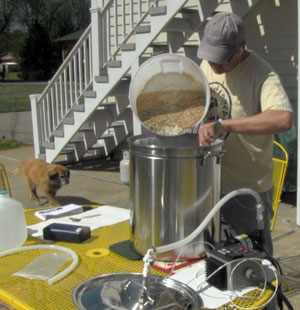“You must boil all grain wort for at least an hour, and sometimes for ninety minutes in some cases.” – Guy you know who taught you all grain brewing
One of the things that homebrewers hear when they first get into brewing all grain is that the full length boil is very important. The boil achieves several objectives:
– Sanitization of the wort
– Coagulation of proteins
– Isomerization of hops
– Volatilization of DMS
– Evaporation of water
All of these are important goals. But is sixty minutes a magic time? Will boiling wort for, say, half that time result in a beer that is sub-standard?
On a recent episode of Basic Brewing Radio, Marshall Schott, who goes by the title “Brülosopher,” shared an experiment attempting to answer this very question. Steve Wilkes and I sampled the same recipe that had been boiled for thirty minutes and sixty minutes, and we had a very hard time telling the difference between the two. Read Marshall’s blog post.
Following that experiment sampling, I decided to put the shorter all grain boil to the test. I designed two pale ale recipes, one with American hop characteristics and one intended to be more of a British influence (see recipes below). Steve and I tasted the beers on an episode of Basic Brewing Video. The bottom line? Both beers were tasty and seemed not to suffer any ill effects from the shorter boil.
I would suppose the defect you’d most likely expect to taste in a shorter boil beer would be Dimethyl Sulfide (DMS). It is suggested that lighter base malts, such as Pilsner, should be boiled for a longer period of time to drive off DMS precursors. DMS is said to give a cooked corn flavor and aroma to finished beer. However, the base malts I used – American two-row and Golden Promise – are kilned for a longer time than Pilsner malt and are less likely to have DMS attributes. Neither of my test beers were “corny,” although our jokes as we were tasting them certainly were.
Protein was apparently not a problem with these beers, either. They were as clear as “normal” unfiltered homebrew usually is.
So, if we’re only boiling for half the time, there are some things that you need to consider in designing recipes. First of all, since you’re lessening the amount of time you’re boiling your bittering hop addition, you’re going to need more hops or higher alpha acid hops to compensate. You can find hop utilization calculators to help you figure this out. The good news is that more hop flavor and aroma is likely to be preserved with the shorter boil time.
Your volume will be more and your gravity will be less at the end of a shorter boil. That is, if you start with the same pre-boil volume that you usually use. So, you’re going to have to adjust your recipe again to compensate.
Is there a down side? So far, I haven’t found one. Boiling for a shorter time may not be appropriate for every recipe or every style. However, for good, drinkable pale ales, spending less time over the brew pot seems to be a legitimate technique.
American Short Boil Pale Ale
Batch size: 5 gallons (19 liters)
11 lbs. (5 kg.) American Two-Row
Mash at 150˚F (66˚C) for one hour
1 oz (28 g) Simcoe Pellets – 30 minutes
1 oz (28 g) Amarillo Pellets – 10 minutes
1 oz (28 g) Cascade Pellets – 5 minutes
Safale US 05 yeast
OG: 1.048 FG: 1.010 ABV: 5%
British Short Boil Pale Ale
Batch size: 5 gallons (19 liters)
10 lbs. (4.5 kg) Golden Promise
.5 lbs. (226 g) 20L Crystal
Mash at 152˚F (67˚C) for one hour
1 oz (28 g) East Kent Goldings – 30 minutes
1 oz (28 g) Fuggles – 5 minutes
Winsor Yeast
OG: 1.050 FG: 1.018 ABV: 4.2%


Speak Your Mind